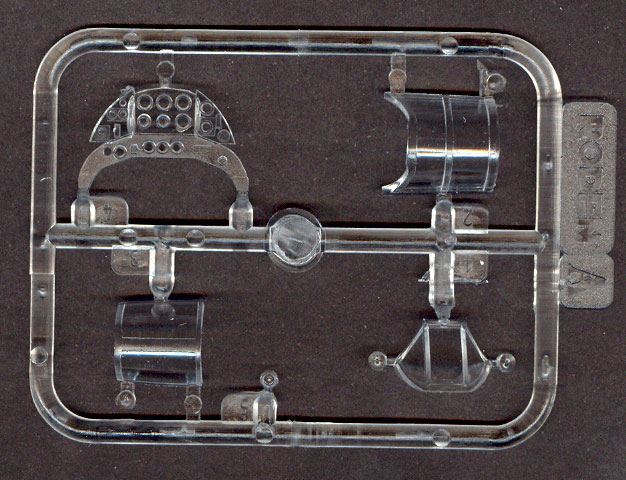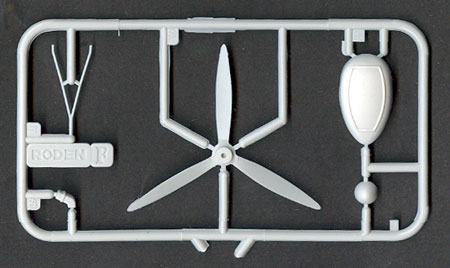S u m m a r y
|
| Catalogue
Number: |
RD405 |
| Scale: |
1/48 |
| Contents and Media: |
94 parts in light grey styrene;
5 parts in clear styrene; markings for five aircraft |
| Price: |
USD$24.97 from Squadron.com |
| Review Type: |
QuickLook |
| Advantages: |
Authentic surface texture;
good details including cockpit and engine; positionable
flying surfaces; very thin trailing edges of flying surfaces; eight marking options and decals
for the tyres; extra parts also applicable to Gladiator Mk.II |
| Disadvantages: |
Some sink marks on fuselage; a
little extra work needed if the arrestor hook is to be used; poorly shaped seat; mould flow lines on wings and
other smaller parts. |
| Recommendation: |
Recommended to early WWII RAF,
FAA
and biplane aficionados. |
Reviewed by Brett Green

Roden's 1/48
Scale Sea Gladiator is available online from Squadron.com
Roden's second 1/48 scale release in the Gladiator family is the Sea
Gladiator.
Roden's 1/48 scale Gladiator comprises 94 parts in light grey styrene,
and an additional 5 parts in clear.
Except for one small sprue with five parts, the plastic is identical to
the Gladiator Mk. I release. This is a good thing, as the Gladiator Mk. I
was a great kit.
The kit parts are generally well moulded, and surface texture is very
impressive. The fabric over ribs looks just right. Panel lines, where
appropriate, are crisply engraved. Depiction of rib tape on the ailerons
is so subtle as to be almost invisible! There are a few sink marks and
stress lines on the outside of the fuselage. These are partly the result
of ambitious moulding of structural detail on the inside of the fuselage.
There are some bigger sink marks on the front face of the propeller blade
too. These will need some attention with putty and a sanding stick. Mould
flow lines are present on the wings and tailplanes, but they will
disappear under a coat of paint.

Locating pins are not widespread on the kit but engineering is robust.
Large tabs help locate the lower wing to each fuselage half, and the upper
wing is supplied as a single, full span part. The trailing edges on the
three wing parts are almost razor sharp - very impressive. Furthermore,
there are locating pins for the top and bottom of the outer struts
on each wing. The cabane struts are secured with locating pins too. All
the flying
surfaces are supplied as separate parts.
Some of the parts are incredibly fine and delicate. Of special note is
Part 68, the fin mast for the aerial wire. The trigger on the control
column and the pitot tubes moulded to the port strut are worthy of
attention too.
The engine is made up of 26 pieces not including the propeller, cowl
and tropical filter. This should look great when finished, but care must
be taken to ensure that it will fit in the three-piece cowl.

The cockpit is also convincing. Raised structural detail is present on
the sidewalls, and the impression of the partial floor is captured quite
well. The instrument panel is a clear part with decal instruments applied
to the rear. The seat lets down this otherwise good aspect of the kit. It
is slab-like, looking more like a refugee from a 1970s-era model than a
high quality offering of 2002.

The additional sprue includes the three-bladed Fairey-Reed metal propeller, spinner,
late-style intake, the bulged dinghy pack for the lower fuselage and the arrestor hook. The first three items are also
applicable to the Gladiator Mk. II, so if you are too impatient to wait
for the inevitable dedicated release of that version (undoubtedly with a
stack of high-quality specific decal options) you can use this kit
in the meantime.

Although the arrestor hook is included, there is no provision for it on
the lower fuselage. In most photos the mechanism seems to be recessed into
the lower fuselage when the hook is retracted. There is also a small but
obvious locating point for the end of the hook rear the rear of the lower
fuselage on the real aircraft. Neither of these features are depicted in
the kit. It won't take long to do it yourself though, if you are so
inclined (and armed with reference - I used the Squadron "Gladiator in
Action" book. Plenty of photos of Sea Gladiators there).
The decals look very good. Markings for eight separate Sea Gladiators are supplied,
although there is not a lot of variety of colours. Most aircraft feature
the shadow-shaded temperate sea scheme, with another subject in overall
black. Colours,
registration and thinness of the decals all appear to be very good. The markings even
include tyre lettering - "Dunlop Aircraft Tyre"!

Instructions are called out in 15 steps using diagrams. Paint
references are supplied for Humbrol, Testor, Gunze and Lifecolor. Each
marking option is covered using a side profile plus upper and lower plan
view. A rigging diagram completes the package.
Roden's 1/48 scale is an impressive kit in the box.
Earlier Roden releases have revealed some construction
challenges, so careful preparation and test fitting is the best formula
for avoiding problems. In particular, I would recommend that the basic
engine part is test-fitted to the assembled cowl, and that the engine is
test fitted repeatedly after each extra component is added. The cockpit
components should be test-fitted in the fuselage to check width before
painting and assembly too.
In common with my comments about the earlier kit, a little
time and care, and a replacement seat, should render a terrific result
from this impressive kit.
Recommended.
Review and Images Copyright © 2003 by
Brett Green
Page Created 28 April, 2003
Last updated 12 August, 2004
Back to HyperScale Main Page
Back to Reviews Page
|
Home | What's
New | Features
| Gallery |
Reviews | Reference
| Forum
| Search